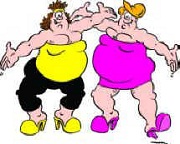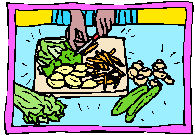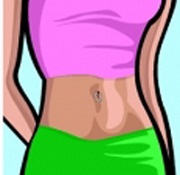Food Mistakes
 The following article is a small excerpt from one of my books. I hope you’ll want to learn more and let me help you to get into the best shape of your life.
The following article is a small excerpt from one of my books. I hope you’ll want to learn more and let me help you to get into the best shape of your life.
It was easier back in the days of the caveman, when we were hunters and the only thing on the table was what we could hunt and gather. NO highly refined, processed and man-made foods. The menu was primitive, but at least there weren’t any experts hovering over us telling us to eat this and to not eat that. We can get food 24/7 and along with this convenience comes the almost nonstop nutritional advice, much of which is constantly changing as new research findings come along or scientists change their minds. What’s good for us today may kill us tomorrow!! And what was supposed to kill us today may save our life tomorrow. You try to keep up with the latest and make the smartest choices but are they as healthy as you think? Here’s are some tips on how to make the very best of your good intentions.
You eat multigrain bread or cereal
Foods labeled 7-grain or multigrain may seem like the healthiest choices, especially with new findings showing that a diet rich in whole grains protects against certain diseases like heart disease and cancer. We don’t know all the reasons behind the benefits, but we do know that intact grains are rich in fiber and nutrients, including vitamin E, B vitamins, and magnesium most of which are stripped away when grains are refined into flour.
Unfortunately, many foods are only posing as rich in whole grains. You need to take a closer look at the labels and you may find there’s not a single whole grain in them. The reason labels can claim that products contain grains even if they’re highly processed and stripped of most of their nutrients and all of their fiber is …White flour is made from grain!!
TO DO: Learn the lingo of food claims. Bread that’s 100% whole grain means just that it contains no refined flour. Cereal that’s made with whole grain may have a little or a lot. Crackers labeled multigrain may not have whole grains at all. To be sure you’re getting the grains you want, check the label. Whole grains should be the first or second ingredient listed. Finding whole grain products is easier now that manufacturers supplying at least 16 g of whole grains per serving, what’s considered an excellent source are stamping their packaging with the Whole Grains Council’s logo.
You buy bottled water laced with vitamins
It’s a measure of how health conscious we’ve become that water is now being sold fortified with nutrients and even medicinal herbs. The label of one leading brand, for example, reports that it supplies half the daily requirement for some nutrients. But to get that amount, you have to drink the whole bottle, which contains 125 calories. And for that you get just 6 of the 40-plus essential nutrients provided by most supplements. An entire bottle, supplies no more vitamin C than you’d get from eating two strawberries.
TO DO: “Save your money.” Drink plain, refreshing, calorie-free water when you’re thirsty and take a multivitamin daily to make sure you get balanced levels of the essential vitamins and minerals.
You choose veggie chips over potato chips
Dozens of munchies are made from carrots, spinach, kale, and even exotic tropical vegetables. But scrutinize their ingredients and you’ll find that vegetable coloring is all most of them have in common with produce. The ingredient labels reveal that vegetables are at the bottom of the list (that means they contribute less, by weight, than ingredients at the top of the list, like oil). Many of these seemingly healthful snacks are still loaded with calories. A 4-ounce bag of Carrot Chips contains 600 calories just as much as Classic potato chips.
TO DO: When you must have chips, look for brands with vegetables at the top of the ingredient list. A tip off to a snack’s healthfulness is its fiber content. One ounce may contain 3 g of fiber, which is not bad for a snack food, but in the calorie department they are about 140 calories per ounce, which makes them almost the same as regular chips. If you’re counting calories, baked potato chips at 110 calories per serving are a better choice. An even healthier snack would be a handful of nuts, loaded with fiber, healthy oils, and vitamins and minerals; they’ll even satisfy your urge to nibble. And if you want an even healthier snack, choose carrot sticks, celery, radishes, or sweet peppers chilled in the refrigerator.
You choose snacks that are made with ”real” fruit
The packaging has pictures of luscious fruit, and the labels claim that there is real fruit inside but don’t count these snacks as one of the four to five daily servings the new dietary guidelines recommend. Current law doesn’t require labels to specify how much fruit is in the product, so manufacturers can brag on packaging that food is made with real fruit if it contains only small amounts of fruit juice.
Concentrated white grape juice or pear juice may sound healthy, but all that really means is fruit sugars and water. Few of these snacks provide any fiber and some contain small amounts of hydrogenated fats (the bad stuff). They also have as many calories as candy does.
TO DO: Treat these snacks as candy and eat them sparingly. Satisfy your sweet tooth with real fruit instead or a pack of raisins or other type of dried fruit.
You buy low-sodium products to cut down on salt
All of us could do with less salt, which has been shown to increase the risk of high blood pressure yet we consume almost twice the daily-recommended amounts. Processed foods represent one of the biggest sources of hidden sodium, so it’s great news that low-sodium alternatives are starting to be made available. The problem is many still contain more salt than the 140 mg most of us should get in a single serving and just 1 tablespoon of reduced sodium soy sauce has 600 mg.
TO DO: Be wary of products labeled less sodium. The law requires that the sodium level be only 25% less than the original product. But if that product happens to be very high in salt to begin with like many soups and broths you may still be getting too much sodium. Be a label sleuth and check to see if sodium levels are around 140-mg. or less per serving.
You drink fat-free milk to bone up on nutrients
Smart move. But if you buy milk in glass or translucent containers, you may not be getting all the nutrients you should be. Although calcium in milk is relatively stable, vitamins A, B2, C, D, and E and amino acids all break down gradually when milk is exposed to light. Milk is especially susceptible because the riboflavin (vitamin B2) it contains acts as a photo sensitizer. Light also oxidizes fat and diminishes the flavor of milk.
TO DO: Buy milk in opaque containers, which eliminate as much light exposure as possible. A container that blocks light will maintain vitamin A, riboflavin, and other nutrients in milk for about 10 days.
You toast your health with a glass of wine or beer
Studies have found that moderate drinkers have about one-third lower risk of heart disease than those who don’t drink. But excessive drinking has also been proven to send blood pressure climbing. New evidence shows that even light to moderate drinking on an empty stomach can contribute to high blood pressure risk and the risk of hypertension was almost 50% higher in people who drank alcoholic beverages without food than in those who drank only with a meal.
TO DO: Enjoy an alcohol drink over dinner. Consuming alcohol with a meal slows the rise of alcohol in your blood and speeds its elimination from your body. Drinking small amounts of alcohol is known to help prevent the formation of small blood clots that might clog arteries and cause a heart attack and which form most often after a big meal. Alcoholic beverages enjoyed with a meal are usually sipped, not chugged, which means you’re less likely to become inebriated. The risks of regular overindulgence include weight gain, depression, and liver and kidney problems.
You grab a granola bar for a quick breakfast
If you eat a morning meal you are slimmer and have lower cholesterol levels and better memory recall than those who don’t. But many of those seemingly healthy breakfast bars so great for eating on the run are basically candy bars in disguise. Even though they may contain granola or fruit, some bars are full of high fructose corn syrup and trans fats to keep them soft and sweet. The rush of sugar will leave you feeling drained and hungry by midmorning.
TO DO: Choose a bar with less than 11 g of sugar, no partially hydrogenated oils (trans fats), and has at least 3 g of fiber, which slows digestion and provides sustained energy. You can always bake your favorite oatmeal-raisin-cookie recipe with half the sugar and half the oil, and pop them into individual plastic bags or hard-boil a half-dozen eggs and grab one each morning along with some fruit and an English muffin for a portable breakfast.
You have an after-dinner mint instead of dessert
The cooling taste of mint may sound like just the thing after a heavy meal, but it could spell trouble. Mints are high on the list of foods that can cause heartburn. Other culprits: caffeine-containing food and beverages, such as chocolate, soda, and coffee.
TO DO: Skip the mints and have a piece of fruit instead. If you’re prone to heartburn, drink a tall glass of water after meals to flush out your esophagus. And then take a stroll. Walking keeps you upright and uses gravity to keep acids from splashing up. Getting into the habit of walking after a meal could help you keep the pounds off and lower your risk of heartburn.
You save restaurant leftovers to reheat later
If you stop for a movie after your meal, your health may be in jeopardy. Your food needs to be in your fridge or freezer within 2 hours (1 hour if it’s over 90° F outside) or you’re risking food poisoning. Another concern is micro waving leftovers in take-home food bags, and containers, and even on some paper plates may leach dangerous chemicals into your food when heated.
TO DO: When re heating your food, place it in microwave-safe containers, preferably glass or ceramic. And make sure you reheat those leftovers to at least 165F to kill off any nasty bugs and bring soups and gravies to a boil.
I know you want to get in shape and look great. Whatever your fitness goal…to slim down…gain muscle…tone your arms or flatten your tummy…I’m here to help you accomplish your goals and to improve your fitness level. If you have enjoyed this article and the many other free features on my site, and would like some more comprehensive information such as fitness books and CD’s to aid you in achieving your health and fitness goals, please visit my ONLINE STORE where you will find innovative natural health and beauty products to help you become the BEST YOU CAN BE !


 The following article is a small excerpt from one of my books. I hope you’ll want to learn more and let me help you to get into the best shape of your life.
The following article is a small excerpt from one of my books. I hope you’ll want to learn more and let me help you to get into the best shape of your life. The following article is a small excerpt from one of my books. I hope you’ll want to learn more and let me help you to get into the best shape of your life.
The following article is a small excerpt from one of my books. I hope you’ll want to learn more and let me help you to get into the best shape of your life. The following article is a small excerpt from one of my books. I hope you’ll want to learn more and let me help you to get into the best shape of your life.
The following article is a small excerpt from one of my books. I hope you’ll want to learn more and let me help you to get into the best shape of your life. The following article is a small excerpt from one of my books.I hope you’ll want to learn more and let me help you to get into the best shape of your life.
The following article is a small excerpt from one of my books.I hope you’ll want to learn more and let me help you to get into the best shape of your life. The following article is a small excerpt from one of my books. I hope you’ll want to learn more and let me help you to get into the best shape of your life.
The following article is a small excerpt from one of my books. I hope you’ll want to learn more and let me help you to get into the best shape of your life. The following article is a small excerpt from one of my books. I hope you’ll want to learn more and let me help you to get into the best shape of your life.
The following article is a small excerpt from one of my books. I hope you’ll want to learn more and let me help you to get into the best shape of your life. The following article is a small excerpt from one of my books.I hope you’ll want to learn more and let me help you to get into the best shape of your life.
The following article is a small excerpt from one of my books.I hope you’ll want to learn more and let me help you to get into the best shape of your life. The following article is a small excerpt from one of my books. I hope you’ll want to learn more and let me help you to get into the best shape of your life.
The following article is a small excerpt from one of my books. I hope you’ll want to learn more and let me help you to get into the best shape of your life.